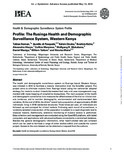| dc.contributor.author | Homan, T | |
| dc.contributor.author | di Pasquale, A | |
| dc.contributor.author | Onoka, K | |
| dc.contributor.author | Kiche, I | |
| dc.contributor.author | Hiscox, A | |
| dc.contributor.author | Mweresa, C | |
| dc.contributor.author | Mukabana, WR | |
| dc.contributor.author | Masiga, D | |
| dc.contributor.author | Takken, W | |
| dc.contributor.author | Maire, N | |
| dc.date.accessioned | 2017-05-15T09:12:20Z | |
| dc.date.available | 2017-05-15T09:12:20Z | |
| dc.date.issued | 2016 | |
| dc.identifier.citation | Int J Epidemiol. 2016 Jun;45(3):718-27. doi: 10.1093/ije/dyw072. Epub 2016 May 16. | en_US |
| dc.identifier.uri | https://www.ncbi.nlm.nih.gov/pubmed/27185811 | |
| dc.identifier.uri | https://academic.oup.com/ije/article-abstract/45/3/718/2572864/Profile-The-Rusinga-Health-and-Demographic | |
| dc.identifier.uri | http://s3.amazonaws.com/academia.edu.documents/45960237/Homan_et_al_2016_Profile_Rusinga_Island_HDSS.pdf?AWSAccessKeyId=AKIAIWOWYYGZ2Y53UL3A&Expires=1494842990&Signature=WgIQlxo7n28ZHbZCAg1%2FYlCIgKk%3D&response-content-disposition=inline%3B%20filename%3DHealth_and_Demographic_Surveillance_Syst.pdf | |
| dc.identifier.uri | http://hdl.handle.net/11295/100910 | |
| dc.description.abstract | The health and demographic surveillance system on Rusinga Island, Western Kenya, was initiated in 2012 to facilitate a malaria intervention trial: the SolarMal project. The project aims to eliminate malaria from Rusinga Island using the nationwide adopted strategy for malaria control (insecticide-treated bed nets and case management) augmented with mass trapping of anopheline mosquitoes. The main purpose of the health and demographic surveillance is to measure the effectiveness of the trial on clinical malaria incidence, and to monitor demographic, environmental and malaria-related data variables. At the end of 2014, the 44 km(2) island had a population of approximately 25 000 individuals living in 8746 residential structures. Three times per year, all individuals are followed up and surveyed for clinical malaria. Following each round of surveillance, a randomly selected cross-section of the population is subject to a rapid diagnostic test to measure malaria. Additionally, extensive monitoring of malaria vectors is performed. Data collection and management are conducted using the OpenHDS platform, with tablet computers and applications with advanced software connected to a centralized database. Besides the general demographic information, other health-related data are collected which can be used to facilitate a range of other studies within and outside the current project. Access to the core dataset can be obtained on request from the authors. | en_US |
| dc.language.iso | en | en_US |
| dc.publisher | University of Nairobi | en_US |
| dc.rights | Attribution-NonCommercial-NoDerivs 3.0 United States | * |
| dc.rights.uri | http://creativecommons.org/licenses/by-nc-nd/3.0/us/ | * |
| dc.subject | Health and demographic surveillance; Malaria; OpenHDS; Rusinga Island | en_US |
| dc.title | Profile: the Rusinga health and demographic surveillance system, western Kenya. | en_US |
| dc.type | Article | en_US |



